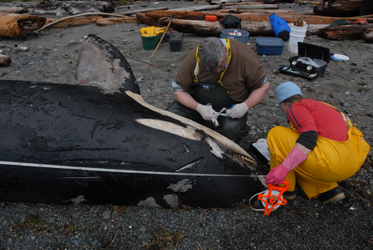
Dr Stephen Raverty
Adjunct Professor
email: Stephen.Raverty@gov.bc.ca
Education:
1984 BSc, Zoology, University of British Columbia, Vancouver, British Columbia; 1987 MSc, Aquatic Veterinary Studies, Institute of Aquaculture, University of Stirling, Stirling, Scotland; 1991 DVM, Western College of Veterinary Medicine, University of Saskatchewan,Saskatoon, Saskatchewan; 1992 PhD, Institute of Aquaculture, University of Stirling, Stirling, Scotland; 2000 Board Certification, Anatomic Pathology, American College of Veterinary Pathology
Current Position: Dr Stephen Raverty is a board certified veterinary pathologist with the Ministry of Agriculture and Lands, Animal Health Center, Abbotsford, BC. For the last 10 years Stephen has been pursuing diagnostic and research interests in stranded marine mammals throughout the northeastern Pacific region. More recently his work has taken him to the arctic and New Zealand.

Stephen at work
Research Interests: When an animal dies, veterinary pathologists like Stephen Raverty investigate possible causes of death. The bodies of livestock, companion animals, and other specimens that have mysteriously died are submitted to the Animal Health Center where postmortem examinations – the dissection and examination of the body to determine cause of death – are undertaken. Raverty works to find out how the animal might have died and screen for health concerns that may not only impact other members of the animal’s population, but may also be transmitted to other animals, including humans.
Raverty volunteered at the Vancouver Aquarium as a youngster, an experience that spurred his interest in veterinary pathology. He now works with B.C.’s Ministry of Agriculture examining deceased animals, and reporting his findings to specimen submitters, including pet owners, farmers, biologists, and veterinarians.

Stephen working with deceased Killer whale at Nootka sound
Raverty is most passionate, however, about his research with marine mammals. With stranded marine mammals, he investigates underlying health issues the animal might have had, and what they might reveal about the health of our ecosystems, particularly the transfer of terrestrial pathogens (germs or diseases from land dwelling species) to the marine environment.
“It’s a wonderful profession to be involved with,” Raverty says about his work, adding that it is tremendously important to ensure animals are healthy for their own well being and society as a whole.
YouTube video of Stephen in action
PUBLICATIONS (selected)
Palacios, G; Nollens, H, Raverty, S, Bussetti, S, Hui, J,Savji, N, Wellehan, J, Lambourn, D, Briese, T and Lipkin, W. Genomic and phylogenetic characterization of a novel reovirus from an aborted Steller sea lion fetus (Eumetopia jubatus). Journal of Virology. Accepted
Dadone, L, Whiteside, D, Black, B, Remedios, A, and Raverty, S. Nasal osteosarcoma and interstitial cell tumor in a Vancouver Island marmot (Marmota vancouverensis). Journal or Zoo and Wildlife Medicine. Journal of Zoo and Wildlife Medicine, 42(2):330-334. 2011.
Gibson, A, Raverty, S, Lambourn, D, Huggins, J, Magargal, S, and Grigg, M Polyparasitism predicts virulence of Toxoplasma gondii in marine sentinel species. PlosNTD. PLoS Neglected Tropical Diseases DOI: 10.1371/journal.pntd.0001142.2011.
Duncan, C, Raverty, S, Stephen, C, Bobsien, B, and Lester, S. Cryptococcus gattii in a horse from Vancouver Island, British Columbia, Canada. Medical Mycology Month 2011, Early Online, 1–5
Norman, S, Raverty, S, Zabek, E, Ethridge, S, Hanson, B, Ford, J, and Morshed, M. In utero maternofetal transmission of Cryptococcus gattii in a wild stranded harbor porpoise (Phocoena phocoena) in the Northeastern Pacific Ocean. Emerging Infectious Diseases. Dis [serial on the Internet]. 2011 Feb 2025. http://www.cdc.gov/EID/content/17/2/304.htm
Colegrove, K, St. Ledger, J, Raverty, S, Jang, S, Bermen, M., and Gaydos, J. K. Salmonella Newport omphaloarteritis in an offshore killer whale (Orcinus orca) neonate stranded along the California Coast. Journal of Wildlife Diseases. 46(4): 1300-1304, 2010
Rotstein, D, West, K, Levine, G, Lockhart, S, Raverty, S, Mohummad, M, and Rowles, T. Cryptococcus gattii VG1 in a spinner dolphin (Stenella longirostris) from Hawaii. Journal of Zoo and Wildlife Medicine. Journal of Zoo and Wildlife Medicine, 41(1):181-183, 2010
Himworth, C, Haulena, M, Lambourn, D, Gaydos, J, Huggins, J, Calambokidis, J, Ford, J, Zaremba, K, and Raverty, S. Pathology and epidemiology of phocid herpesvirus-1 infections in wild and rehab harbor seals (Phoca vitulina) in the Northeastern Pacific. Journal of Wildlife Diseases. 46(3): 1046-1051, 2010
Kersh, G, Lambourn, D, Self, J, Akmajian, A, Stanton, J, Baszler, T, Raverty, S, and Massung, R. Coxiella burnetii infection of a Steller sea lion (Eumetopias jubatus) found in Washington state. Journal of Clinical Microbiology, 48(9): 3428-3431, 2010
Zuerner, R, Cameron, C, Raverty, S, Robinson, J, Colegrove, K, Norman, S, Lambourn, D, Jeffries, S and Gulland, F. Geographical dissemination of Leptospira interrogans serovar Pomona during seasonal migration of California sea lions. Veterinary Microbiology. 137:105-110, 2009
Gaydos, J, Zabek, E, and Raverty, S. Yersinia pseudotuberculosis septicemia in a beaver from Washington State. Journal of Wildlife Diseases, 45(4):1182-1186, 2009
Huggins, F, Raverty, S, Nielsen, O, Sharp, N, Robertson, J, and Ralston, N, An XAFS investigation of mercury and selenium in beluga whale tissues. Environmental Bioindicators, 4(4): 291-302, 2009
Douglas, A.B., Calambokidis, J., Raverty, S., Jeffries, S., Lambourn, D. and Norman, S. Incidence of ship strikes of large whales in Washington State. Journal of the Marine Biological Association of the United Kingdom 88:1121-1132, 2008
Maggi, R, Raverty, S, Lester, S, Huff, D, Haulena, M, Ford, S, Nielsen, O, Robinson, J and Breitschwerdt, B. Infection with Bartonella henselae in captive and hunter harvested juvenile beluga whales (Delphinapterus leucas) and sea lions (Eumetopias jubatus). Journal of Wildlife Diseases. 44(4):871-7, 2008
Cameron, C, Zuerner, R, Raverty, S, Colgrove, K, Norman, S, Lambourn, D, Jeffries, S and Gulland, F. Use of polymerase chain reaction to detect Leptospira infection amongst pinniped populations during a 2004 outbreak along the west coast of North America. Journal of Clinical Microbiology. 46(5): 1728-1733, 2008


